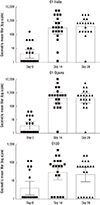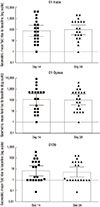1. Cholera vaccines: WHO position paper. Wkly Epidemiol Rec. 2010; 85:117–128.
2. World Health Organization. Background pager on the integration of oral cholera vaccines into global cholera control programmes. Geneva: WHO;2009.
3. Vu DT, Hossain MM, Nguyen DS, Nguyen TH, Rao MR, Do GC, Naficy A, Nguyen TK, Acosta CJ, Deen JL, et al. Coverage and costs of mass immunization of an oral cholera vaccine in Vietnam. J Health Popul Nutr. 2003; 21:304–308.
4. Quick RE, Venczel LV, González O, Mintz ED, Highsmith AK, Espada A, Damiani E, Bean NH, De Hannover EH, Tauxe RV. Narrow-mouthed water storage vessels and in situ chlorination in a Bolivian community: a simple method to improve drinking water quality. Am J Trop Med Hyg. 1996; 54:511–516.
5. Kanungo S, Paisley A, Lopez AL, Bhattacharya M, Manna B, Kim DR, Han SH, Attridge S, Carbis R, Rao R, et al. Immune responses following one and two doses of the reformulated, bivalent, killed, whole-cell, oral cholera vaccine among adults and children in Kolkata, India: a randomized, placebo-controlled trial. Vaccine. 2009; 27:6887–6893.
6. Mahalanabis D, Lopez AL, Sur D, Deen J, Manna B, Kanungo S, von Seidlein L, Carbis R, Han SH, Shin SH, et al. A randomized, placebo-controlled trial of the bivalent killed, whole-cell, oral cholera vaccine in adults and children in a cholera endemic area in Kolkata, India. PLoS One. 2008; 3:e2323.
7. Sur D, Lopez AL, Kanungo S, Paisley A, Manna B, Ali M, Niyogi SK, Park JK, Sarkar B, Puri MK, et al. Efficacy and safety of a modified killed-whole-cell oral cholera vaccine in India: an interim analysis of a cluster-randomised, double-blind, placebo-controlled trial. Lancet. 2009; 374:1694–1702.
8. Guidelines for the production and control of inactivated oral cholera vaccines: annex 3, WHO technical report. 2004. Series No. 924.
9. Anh DD, Canh do G, Lopez AL, Thiem VD, Long PT, Son NH, Deen J, von Seidlein L, Carbis R, Han SH, et al. Safety and immunogenicity of a reformulated Vietnamese bivalent killed, whole-cell, oral cholera vaccine in adults. Vaccine. 2007; 25:1149–1155.
10. Jertborn M, Svennerholm AM, Holmgren J. Saliva, breast milk, and serum antibody responses as indirect measures of intestinal immunity after oral cholera vaccination or natural disease. J Clin Microbiol. 1986; 24:203–209.
11. Attridge SR, Johansson C, Trach DD, Qadri F, Svennerholm AM. Sensitive microplate assay for detection of bactericidal antibodies to Vibrio cholerae O139. Clin Diagn Lab Immunol. 2002; 9:383–387.
12. Gotuzzo E, Butron B, Seas C, Penny M, Ruiz R, Losonsky G, Lanata CF, Wasserman SS, Salazar E, Kaper JB. Safety, immunogenicity, and excretion pattern of single-dose live oral cholera vaccine CVD 103-HgR in Peruvian adults of high and low socioeconomic levels. Infect Immun. 1993; 61:3994–3997.
13. Taylor DN, Cárdenas V, Perez J, Puga R, Svennerholm AM. Safety, immunogenicity, and lot stability of the whole cell/recombinant B subunit (WC/rCTB) cholera vaccine in Peruvian adults and children. Am J Trop Med Hyg. 1999; 61:869–873.
14. Qadri F, Svennerholm AM, Shamsuzzaman S, Bhuiyan TR, Harris JB, Ghosh AN, Nair GB, Weintraub A, Faruque SM, Ryan ET, et al. Reduction in capsular content and enhanced bacterial susceptibility to serum killing of Vibrio cholerae O139 associated with the 2002 cholera epidemic in Bangladesh. Infect Immun. 2005; 73:6577–6583.
15. Saha D, LaRocque RC, Khan AI, Harris JB, Begum YA, Akramuzzaman SM, Faruque AS, Ryan ET, Qadri F, Calderwood SB. Incomplete correlation of serum vibriocidal antibody titer with protection from Vibrio cholerae infection in urban Bangladesh. J Infect Dis. 2004; 189:2318–2322.
16. Chatterjee SN, Chaudhuri K. Lipopolysaccharides of Vibrio cholera: I. physical and chemical characterization. Biochim Biophys Acta. 2003; 1639:65–79.
17. Weintraub A, Widmalm G, Jansson PE, Jansson M, Hultenby K, Albert MJ. Vibrio cholerae O139 Bengal possesses a capsular polysaccharide which may confer increased virulence. Microb Pathog. 1994; 16:235–241.








 PDF
PDF ePub
ePub Citation
Citation Print
Print







 XML Download
XML Download